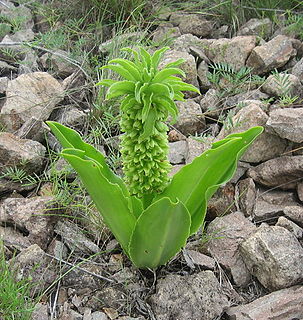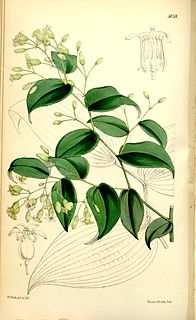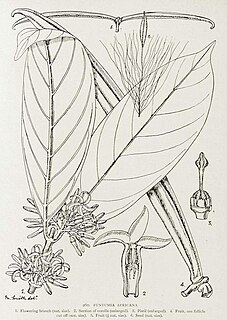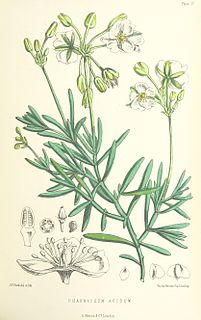
Euclea, from the Greek eukleia meaning "glory and fame", denotes a group of flowering plants in the Ebenaceae or ebony family. They were described as a genus by Linnaeus in 1774. The genus includes evergreen trees and shrubs, native to Africa, the Comoro Islands and Arabia. Several species are used for timber, producing a hard, dark heartwood timber similar to ebony.

Habenaria, commonly called rein orchids or bog orchids, is a widely distributed genus of orchids in the tribe Orchideae. About 880 species of Habenaria have been formally described. They are native to every continent except Antarctica, growing in both tropical and subtropical zones.

Anchomanes is a genus of flowering plants in the family Araceae. The genus is native to tropical Africa.

Eucomis is a genus of flowering plants in the family Asparagaceae, subfamily Scilloideae, native to southern Africa. Most species of this genus are commonly referred to as pineapple flowers or pineapple lilies. They are bulbous perennials with basal rosettes of leaves and stout stems covered in star-shaped flowers with a tuft of green bracts at the top, superficially resembling a pineapple – hence the common names.
Jodrellia is a genus of flowering plants in the family Asphodelaceae, first described as a genus in 1978. The genus is native to eastern + south-central Africa, and has two recognized species.
- Jodrellia fistulosa(Chiov.) Baijnath - Ethiopia, Eritrea, Tanzania, Malawi, Zambia, Zimbabwe
- Jodrellia migiurtina(Chiov.) Baijnath - Ethiopia, Somalia, Kenya
Radinosiphon is a genus of flowering plants in the family Iridaceae first described as a genus in 1932. It is native to southern + southeastern Africa.
Ypsilopus is a genus of flowering plants from the orchid family, Orchidaceae native to Africa.
- Ypsilopus erectus(P.J.Cribb) P.J.Cribb & J.Stewart - Tanzania, Mozambique, Malawi, Zambia, Zimbabwe, South Africa
- Ypsilopus leedaliiP.J.Cribb - Tanzania
- Ypsilopus liaeDelep. & J.-P.Lebel - Rwanda
- Ypsilopus longifolius(Kraenzl.) Summerh. - Tanzania, Kenya
- Ypsilopus viridiflorusP.J.Cribb & J.Stewart - Tanzania

Taeniophyllum, commonly known as ribbon roots or 带叶兰属 is a genus of about 240 species of epiphytic or lithophytic plants from the orchid family, Orchidaceae. Plants in this genus are more or less leafless with a very short stem and roots that are often flat, green and photosynthetic. The flowers are small, short-lived, flat or tube-shaped and arranged on short, thin flowering stems. Orchids in this genus are found in Africa, tropical and subtropical Asia, New Guinea, Australia and some Western Pacific Islands.
Neobolusia is a genus of flowering plants from the orchid family, Orchidaceae. It contains 3 known species, all native to eastern and southern Africa.

Schizochilus is a genus of flowering plants from the orchid family, Orchidaceae. It is native to southern and eastern Africa.
Solenangis is a genus of flowering plants from the orchid family, Orchidaceae. It is native to sub-Saharan Africa.
Summerhayesia is a genus of flowering plants from the orchid family, Orchidaceae. It has two known species, both native to tropical Africa.

Behnia is a genus of flowering plants. In the APG III classification system, it is placed in the family Asparagaceae, subfamily Agavoideae. There is only one known species, Behnia reticulata, native to southern Africa.

Daubenya is a genus of bulbous flowering plants in the family Asparagaceae, subfamily Scilloideae. It is native to the Cape Province of South Africa.
Camptorrhiza is a genus of plants native to India and southern Africa. It contains two recognized species:
Coddia is a monotypic genus of flowering plants in the family Rubiaceae. The genus contains only one species, viz. Coddia rudis, which is native to Mozambique, Zimbabwe, South Africa, and Eswatini.
Dictyophleba is a genus of flowering plants in the family Apocynaceae first described as a genus in 1898. It is native to Africa and to the Comoros Islands in the Indian Ocean.
- Dictyophleba leonensis(Stapf) Pichon - West Africa from Cameroon to Liberia
- Dictyophleba lucida(K.Schum.) Pierre - Comoros, central + southern Africa from Nigeria east to Tanzania and south to Zimbabwe
- Dictyophleba ochracea(K.Schum. ex Hallier f.) Pichon - central Africa from Nigeria to Zaire
- Dictyophleba rudensHepper - Cameroon
- Dictyophleba setosaB.de Hoogh - Cameroon, Gabon
- Dictyophleba stipulosa(S.Moore ex Wernham) Pichon - from Ivory Coast to Congo-Brazzaville

Funtumia is a genus of flowering plants in the family Apocynaceae first described as a genus in 1900. It is native to Africa.

Kewa is a genus of flowering plants, consisting of eight species of succulent sub-woody plants, native to eastern and southern Africa, including Saint Helena and Madagascar. These are small shrubs or herbs that form cushions and have edible, acid-tasting leaves. Kewa is the only genus in the family Kewaceae.
Protea dracomontana, the Nyanga protea or the Drakensberg sugarbush, is a flowering plant that belongs within the genus Protea. The plant is found in the Eastern Cape, Lesotho, KwaZulu-Natal and the escarpment of the Free State, as well as eastern Zimbabwe. In Zimbabwe this species is only known from a disjunct subpopulation confined to the summit of Mount Nyangani.










